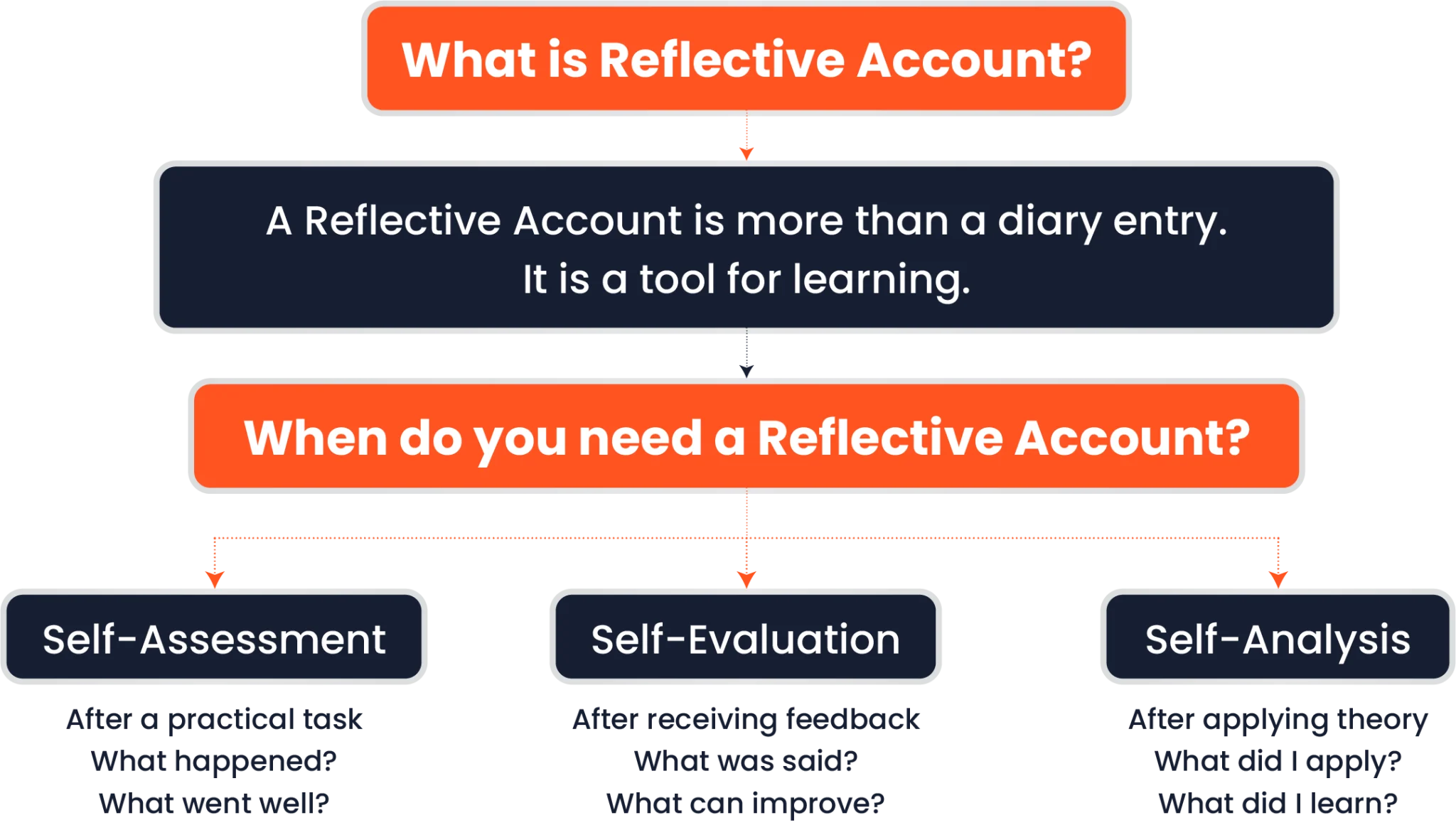If you have ever been asked to reflect on an instance as part of your learning, you must have wondered where to start. Writing a reflective account at first looks pretty daunting as it is not about explaining your experience, but about what you learn from it.
Key Takeaways:
- Reflective writing transforms experience into insight, helping learners critically evaluate actions, lessons learned, and improvements for professional and personal growth.
- Effective reflection bridges theory and practice, providing structured self-analysis that connects academic learning with real-life applications in various fields.
- A strong reflective account requires clarity, evidence, and structure, ensuring meaningful evaluation that meets assessment criteria while providing deeper learning and self-awareness.
A reflective account is a personalised piece of writing that explains how you carried out a task or experienced an event, with the aim of meeting specific assessment criteria. It should be written in a clear and structured way about an instance, evaluating what went well, what could have been improved, and how it has contributed to your development.
This blog will act as a guide and explain the purpose of reflection, when and where it is required, what it involves, and how to present it effectively to meet assessment expectations

What is a Reflective Account?
Reflective account or reflective practice is a written record of the process of thoughtfully reviewing real-life situations you have encountered to drive insight and understanding that informs future actions.
The process involves:
- Analysing your actions
- Identifying what you learned
- Considering how your thinking or approach has changed
- Explaining how this will impact your future professional practice
This goes beyond mere description; it is an analytical practice which requires critical analysis and evaluation of what occurred and why.
Reflective practice is commonly used in various fields, such as education, healthcare, social work, business and vocational training. They are often required as part of formal qualifications, workplace assessments, or Continuous Professional Development (CPD).
In other words,
A reflective account enables you to bridge the gap between theory and practice, allowing you to learn from real experiences and apply that insight to future situations.
When and Where is Reflection Required?
Reflective accounts are often used in qualifications and professional settings where you are required to evaluate your own performance. They are typically required after practical acitivities, where you must critically reflect to demonstrate learning, in line with specific assessment criteria.
Here are some common scenarios where reflective writing is expected:
1. After Completing a Practical Task (Self-Assessment)
Reflect on what you did, how you did it, and what the outcomes were. This helps identify what went well and what could be improved.
2. In Response to Feedback (Self-Evaluation)
Evaluate feedback from tutors or colleagues to understand your strengths and areas for development. Use it to plan future improvements.
3. Applying Theory to Practice (Self-Analysis)
Analyse how you used theoretical knowledge in a real-life situation. Explain how it influenced your decisions or actions.
Your reflections should be based on real experiences that can be backed up by observation or witness statements. This ensures your account is credible and valid.
Why is There a Need for Reflection Practice?
Reflective accounts are essential for demonstrating how practical experience contributes to your learning and development. It is a way that can turn everyday experience into meaningful learning. Reflective writing enable you to:
Encourages Deeper Learning and Self-Awareness: Move beyond surface-level thinking. It allows you to explore your feelings, reactions, and thoughts, which promotes a more profound understanding of your experiences.
Articulate the Reasoning Behind Your Actions and Decisions: Aallows you to explain why you made confident choices or responded in a particular way, showing your ability to think critically and act with intention.
Connect Theory to Practice: Bridges the gap between what you learn in training and how you apply it in real-life situations. It turns abstract ideas into practical knowledge you can use.
Identify Strengths and Areas for Improvement: Clarify your abilities and where to focus your development efforts.
Supports Personal and Professional Growth: Encourage continuous development by helping you track your progress, achievements, and learning journey over time.
Learning Gained from Experience: Shape how you approach similar situations in the future, making you a more thoughtful, prepared, and adaptive practitioner.
Used as Evidence in Portfolios and Assessments: Serve as solid, written proof of your skills and competence in vocational qualifications and CPD portfolios.
Understanding the Difference Between Workplace Example vs Reflective Account
Many learners confuse workplace examples with reflective accounts, but they serve different purposes. While both are important, a reflective account goes much deeper than simply describing what you did.
The following comparison outlines the key differences:
| Aspect | Workplace Example (Descriptive) | Reflective Account (Analytical & Evaluative) |
|---|---|---|
| Focus | What happened during the task or activity | What was learned, how it affected you, and how it will shape future practice |
| Content | Task/event description including actions and outcomes | Analysis of successes and challenges; lessons learned; changes for the future |
| Purpose | Demonstrate that a task was completed | Demonstrate insight, professional development, and critical thinking |
| Key Questions | What? Where? When? Who? | How? Why? So what? What next? |
| Content | “Supporting the new team member highlighted the importance of adapting my communication style. I learned to check understanding and will apply this approach in future inductions.” | “I supported a new team member by showing them how to complete daily care records.” |
What are the Core Elements of a Reflective Account?
When writing a reflective account, think of it as answering a series of important questions that help your reader understand your experience, learning, and development. Here’s what you should include:
- What Happened?
Briefly describe the task, situation, or event. Set the scene clearly, but avoid too much background detail.
- What Was Your Role?
Explain what you did, your decisions, and how you contributed. Focus on your actions and involvement.
- What Went Well?
Identify the successes. What were you pleased with, and what actions or strategies were effective?
- What Didn’t Go Well?
Be honest about challenges or mistakes. What didn’t go as planned, and what were the consequences?
- What Could Have Been Done Differently?
Think about and explain any changes you would make.. What alternative approaches or improvements could have led to better outcomes.
- What Did You Learn?
Reflect on what the experience taught you. This could be about your skills, knowledge, behaviour, or approach.
- How Will You Apply This Learning in the Future?
Explain how the experience will influence your future practice. How will this learning inform your approach if you face the same or a similar situation again, and what strategies or steps will you take to improve your performance next time?

Key Principles for How to Write an Effective Reflective Account
To write a meaningful and assessment-ready reflective account, it’s important to follow key principles that ensure clarity, professionalism, and personal insight. Here’s what you need to keep in mind:
Personal Perspective: Your reflective account should focus on your own thoughts, feelings, and experiences. It’s a personal reflection, not a general observation.
Evidence-Based: Back up your reflection with real examples. What you did, observed, or learned. This makes your reflective account credible and meaningful.
Analytical Thinking: Your reflective account should not be descriptive, but it should reflect on why things happened the way they did, what you learned, and how it changed your understanding or behaviour.
Structured Writing: Organise your reflection with a clear beginning, middle, and end. Make sure each part flows logically and answers the key reflective questions.
Relevance to Standards or Objectives: Link your reflection to specific learning outcomes, assessment criteria, or professional competencies, where required.
Appropriate Level of Detail: Give enough context for your reader to understand the situation, but don’t over-describe. Stay focused on the most relevant aspects.
Tone and Style: Keep your writing formal, objective, and professional. Even though it’s about your experience, avoid casual language or overly emotional phrasing.
Reflecting When No Issues Occurred: If everything went smoothly, reflect on what made it successful. Which skills, factors, preparation, or decisions contributed to the positive outcome?
Conclusion
The Level 5 Diploma in Teaching (Further Education and Skills) is a new standard for those aiming to build a successful and impactful career in post-16 education. This qualification provides a comprehensive foundation in pedagogy, inclusive practice, and practical classroom application. As the recognised pathway to QTLS status, it opens up diverse opportunities across the further education landscape, from colleges and training providers to adult learning centres and beyond.





